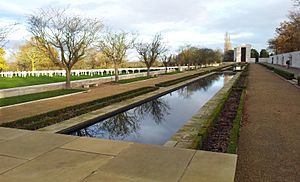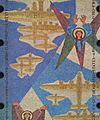Cambridge American Cemetery and Memorial facts for kids
Quick facts for kids Cambridge American Cemetery and Memorial |
|
|---|---|
| American Battle Monuments Commission | |

Cambridge American Cemetery headstones, with the memorial building behind.
|
|
| Used for those deceased 1941–1945 | |
| Established | 1943 |
| Location | 52°12′58″N 0°03′14″E / 52.2161°N 0.0538°E near Cambridge, England
|
| Designed by | Perry, Shaw, Hepburn and Dean (architects) Olmsted Brothers (landscaping) |
| Total burials | 3,812 |
|
Unknowns
|
24 |
| Burials by war | |
|
World War II 3,812
|
|
| Statistics source: American Battle Monuments Commission | |
The Cambridge American Cemetery and Memorial is a special place in England. It honors American soldiers who died during World War II. This cemetery is located near Cambridge, England. It was officially opened in 1956. The cemetery covers about 30 acres. It is home to the graves of 3,812 American service members. This includes airmen and sailors. The American Battle Monuments Commission (ABMC) looks after this cemetery. It is one of 26 such cemeteries around the world.
Contents
A Special Place for Heroes
The University of Cambridge gave 30.5 acres of land for this cemetery in 1943. This land was used as a temporary burial site during World War II. After the war, the American Battle Monuments Commission chose this spot. They decided it would be the permanent cemetery and memorial in the United Kingdom.
Many American war dead from other temporary cemeteries were moved here. Also, about 58% of the fallen soldiers were sent back home. Their families had asked for them to be buried closer to home. The Cambridge American Cemetery and Memorial was officially opened on July 16, 1956.
Who is Buried Here?
The cemetery has 3,809 headstones. These mark the graves of 3,812 service members. They include airmen who died over Europe. Sailors from North Atlantic convoys are also buried here.
There is also a special Wall of the Missing. It lists the names of 5,127 missing service members. Most of these brave individuals were lost at sea. They died during the Battle of the Atlantic. Others were lost during air attacks over Europe.
Some members of the Commonwealth of Nations are also buried here. These were American citizens who served in British forces. They mainly served in the Royal Air Force. Their graves are cared for by the Commonwealth War Graves Commission.
In May 2014, a new visitor center opened. It has exhibits about the people buried or remembered here. It also tells the story of the wider World War II battles they fought in.
Famous People Remembered Here
Some well-known people are remembered at this memorial. Their bodies were not found or were lost at sea.
- Vincent F. Harrington (1903–1943): A US Representative and US Army Air Forces officer.
- John Martin Howard (1917-1942): A US Navy officer. He was buried at sea.
- Joseph P. Kennedy Jr. (1915–1944): He was the older brother of President John F. Kennedy. He was lost at sea.
- Glenn Miller (1904–1944): A famous jazz bandleader and trombonist. He was lost at sea.
- Leon Vance (1916–1944): A US Army Air Forces pilot. He received the Medal of Honor. He was lost at sea.
- Three crew members from the B-17 Flying Fortress Mi Amigo. This plane crashed in Sheffield. All 10 crew members died. Seven were later sent back to the US.
The Memorial Building and Chapel
The main memorial building is quite large. It is 85 feet long, 30 feet wide, and 28 feet high. It is made from a special stone called Portland stone. The large wooden doors are decorated with images of World War II military equipment.
Inside, the memorial has a big museum room. At the far end, there is a small chapel. A huge map on the wall shows the air missions flown from East Anglia. It also shows the convoys that crossed the North Atlantic. The walls and ceiling have beautiful mosaics. They show angels and ghostly aircraft.
Designing the Memorial
The architects who planned the site were Perry, Shaw, Hepburn and Dean. The beautiful gardens and landscape were designed by the Olmsted Brothers company.
Images for kids







